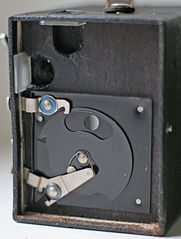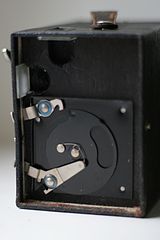Rotation lock
The rotary shutter is a type of camera shutter construction that, in contrast to the central shutter , does not move its components back and forth, but, like the focal plane shutter, only in one direction. Constructively, it is related to the rotating aperture of film cameras. In contrast to the focal plane shutter and rotary shutter, however, the opening is constant and different exposure times are achieved through different speeds .
Agfa box closure open
Applications
In photography , the rotary shutter is used for some special tasks because, unlike other mechanical shutters used in photography, it does not have to be cocked and allows a very quick sequence of images. The rotary shutter is used in the robotic viewfinder camera and in the Olympus pen half-format SLR camera .
Ballistic cameras are also equipped with rotary locks if they are used to measure balloon probes or missile tests . The BC-4 from the Swiss company Wild Heerbrugg used in satellite geodesy was also built in a version with rotating shutters, which are used to generate exact time stamps . The tracks recorded by the satellites are "chopped up" into a series of short image points by two disks rotating in opposite directions.
Advantages and disadvantages
A design disadvantage of the rotary lock is its relatively large space requirement. On the other hand, the advantage is the low acceleration, which makes cameras with a rotation lock ideal for instrumentation purposes.
See also: series of images


